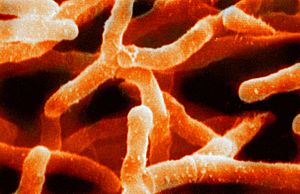Actinobacteria facts for kids
Quick facts for kids Actinobacteria |
|
|---|---|
 |
|
| Actinomyces israelii. | |
| Scientific classification | |
| Domain: | |
| Phylum: |
Actinobacteria
Margulis, 1900
|
| Classes | |
|
Actinobacteria |
|
The Actinobacteria are a special group of bacteria. They are known as gram-positive bacteria, which means they look a certain way under a microscope after a special test. Most Actinobacteria live in the soil, where they are super important!
These tiny organisms are some of the most common living things in soil. They help break down dead plants and animals, a process called decomposition. This helps create humus, which is rich, dark soil that is great for growing plants.
Some Actinobacteria, like a type called Streptomyces, used to be thought of as fungi. This is because they grow in branching shapes, a bit like the root-like parts of fungi called hyphae. But scientists later found out they are definitely bacteria! All Actinobacteria need oxygen to live, which means they are aerobic. While many are helpful, a few types can cause sickness. These are called pathogens, like Mycobacterium, which can cause diseases. Some Actinobacteria also love hot places and are called thermophilic.
Contents
What are Actinobacteria?
Actinobacteria are a large group of single-celled organisms. They are a type of bacterium, which are tiny living things that you can only see with a microscope. They are known for being "gram-positive." This means they have a thick cell wall that holds onto a special purple dye used in a lab test. This test helps scientists identify different kinds of bacteria.
Where do Actinobacteria live?
Most Actinobacteria live in the soil. They are found almost everywhere soil exists, from your backyard to forests and farms. They are very important for keeping the soil healthy. Some types can also live in water or even inside plants and animals.
What do Actinobacteria do?
Actinobacteria play many important roles in nature:
- Recycling Nutrients: They are like the clean-up crew of the soil. They break down dead plants and animals, turning them back into simple nutrients that new plants can use to grow. This process is called decomposition.
- Making Humus: When they break down dead things, they help create humus. Humus is the dark, rich part of soil that makes it fertile and helps it hold water.
- Producing Medicines: Many types of Actinobacteria, especially Streptomyces, are famous for making antibiotics. Antibiotics are medicines that fight off harmful bacteria and save lives. Scientists have discovered many useful antibiotics from these tiny organisms.
- Helping Plants: Some Actinobacteria form special partnerships with plants. They can help plants get nutrients from the soil, making the plants grow stronger and healthier.
Good and Bad Actinobacteria
Most Actinobacteria are helpful and important for the environment. However, like many groups of living things, a few types can cause problems.
- Helpful Actinobacteria: These are the ones that break down waste, create healthy soil, and produce antibiotics. They are essential for life on Earth.
- Harmful Actinobacteria: A small number of Actinobacteria are pathogens. This means they can cause diseases in humans, animals, or plants. For example, some Mycobacterium species can cause serious illnesses.
See also
 In Spanish: Actinobacterias para niños
In Spanish: Actinobacterias para niños

